
The Mitsubishi A5M, formal Japanese Navy designation Mitsubishi Navy Type 96 Carrier-based Fighter (九六式艦上戦闘機), experimental Navy designation Mitsubishi Navy Experimental 9-Shi Carrier Fighter, company designation Mitsubishi Ka-14, was a WWII-era Japanese carrier-based fighter aircraft. The Type number is from the last two digits of the Japanese imperial year 2596 (1936) when it entered service with the Imperial Navy.

The Mitsubishi A7MReppū was designed as the successor to the Imperial Japanese Navy's A6M Zero, with development beginning in 1942. Performance objectives were to achieve superior speed, climb, diving, and armament over the Zero, as well as better maneuverability – all parameters that were ultimately achieved towards the end of its development in 1945. However, limitations on Japanese industry towards the end of the war prevented the A7M from ever entering mass production or being deployed for active duty, and it never saw active service. Its Allied reporting name was "Sam".
The Nakajima Ki-116 was a late-World War II aircraft developed for the Imperial Japanese Army Air Force. It was essentially a Ki-84 Hayate with the Nakajima Ha-45 engine replaced with a Mitsubishi Ha-112. The design was handled by Mansyū Aircraft in Manchukuo, and thus it is often designated Mansyū Ki-116.

The Kawasaki Ki-61 Hien is a Japanese World War II fighter aircraft. Used by the Imperial Japanese Army Air Service, it was designated the "Army Type 3 Fighter" (三式戦闘機). Allied intelligence initially believed Ki-61s were Messerschmitt Bf 109s and later an Italian Macchi C.202, which led to the Allied reporting name of "Tony", assigned by the United States War Department. The design originated as a variant of the Kawasaki Ki-60, which never entered production. The Ki-61 became the only mass-produced Japanese fighter of the war to use a liquid-cooled inverted V engine. Over 3,000 Ki-61s were produced. Initial prototypes saw action over Yokohama during the Doolittle Raid on 18 April 1942, and continued to fly combat missions throughout the war.

The Kawasaki Ki-100 (キ100) is a single-seat single-engine monoplane fighter aircraft used by the Imperial Japanese Army Air Service (IJAAS) during World War II. The Japanese Army designation was "Type 5 Fighter". It was not assigned an Allied code name.

The Nakajima Ki-84 Hayate is a single-seat fighter flown by the Imperial Japanese Army Air Service in the last two years of World War II. The Allied reporting name was "Frank"; the Japanese Army designation was Army Type 4 Fighter. The Ki-84 is generally considered the best Japanese fighter to operate in large numbers during the conflict. The aircraft boasted high speed and excellent maneuverability with an armament that gave it formidable firepower. The Ki-84's performance matched that of any single-engine Allied fighter it faced, and its operational ceiling enabled it to intercept high-flying B-29 Superfortress bombers. Pilots and crews in the field learned to take care with the plane's high-maintenance Nakajima Homare engine and landing gear prone to buckling. The difficulties of Japan's situation late in the war took a toll on the aircraft's field performance as manufacturing defects multiplied, good quality fuel proved difficult to procure, and experienced pilots grew scarce. Nevertheless, a well-maintained Ki-84 was Japan's fastest fighter. A total of 3,514 aircraft were built.
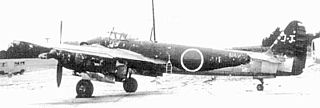
The Nakajima J5N was an abandoned Japanese prototype fighter aircraft of the World War II era. J5N was developed as twin-engine interceptor for countering attacks by Boeing B-29 Superfortress.

The Kawasaki Ki-45 Toryu is a two-seat, twin-engine heavy fighter used by the Imperial Japanese Army in World War II. The army gave it the designation "Type 2 Two-Seat Fighter"; the Allied reporting name was "Nick". Originally serving as a long-range escort-fighter, the design — as with most heavy fighters of the period — fell prey to smaller, lighter, more agile single-engine fighters. As such, the Ki-45 instead served as a day and nighttime interceptor and strike fighter.

The Kawasaki Ki-10 was the last biplane fighter used by the Imperial Japanese Army, entering service in 1935. Built by Kawasaki Kōkūki Kōgyō K.K. for the Imperial Japanese Army, it saw combat service in Manchukuo and in North China during the early stages of the Second Sino-Japanese War. Its reporting name given by the Allies was "Perry".
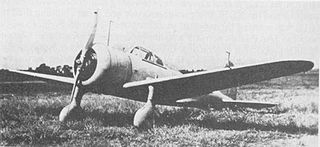
The Nakajima Ki-27 was the main fighter aircraft used by the Imperial Japanese Army Air Service up until 1940. Its Allied nickname was "Nate", although it was called "Abdul" in the "China Burma India" (CBI) theater by many post-war sources; Allied Intelligence had reserved that name for the nonexistent Mitsubishi Navy Type 97 fighter, expected to be the successor to the carrier-borne Type 96 with retractable landing gear and an enclosed cockpit.

The Kawasaki Ki-60 was an experimental Japanese pre-World War II fighter aircraft that used a license-built (Kawasaki) DB 601 liquid-cooled engine. This was, at that time, an unusual choice because the majority of Japanese aircraft at that time used air-cooled radial engines.
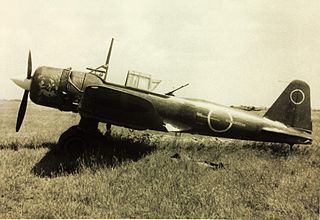
The Mitsubishi Ki-51 was a light bomber/dive bomber in service with the Imperial Japanese Army during World War II. It first flew in mid-1939. Initially deployed against Chinese forces, it proved to be too slow to hold up against the fighter aircraft of the other Allied powers. However, it performed a useful ground-attack role in the China-Burma-India theater, notably from airfields too rough for many other aircraft. As the War drew to a close, the Japanese began using them in kamikaze attacks. Total production was around 2,385.
The Kawasaki Ki-102 or Type 4 Attack Plane was a Japanese warplane of World War II. It was a twin-engine, two-seat, long-range heavy fighter developed to replace the Ki-45 Toryu. Three versions were planned: the Ki-102 Kō day fighter, Ki-102 Otsu ground-attack and Ki-102 Hei night fighter. This aircraft's Allied reporting name was "Randy".

The Tachikawa Ki-94 was a single-seat fighter-interceptor aircraft project undertaken by the Tachikawa Aircraft Company and to be operated by the Imperial Japanese Army. The project refers to two aircraft designs: the Ki-94-I and the Ki-94-II, both of which did not advance beyond the mock-up and prototype stage respectively.
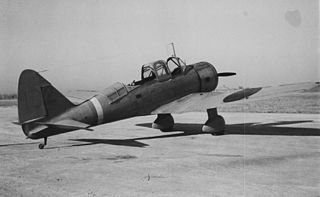
The Tachikawa Ki-36 was a Japanese army co-operation aircraft of World War II. It was a two-seat, low-wing monoplane with a single piston engine and fixed, tailwheel-type undercarriage.

The Tachikawa Ki-55 was a Japanese advanced trainer.
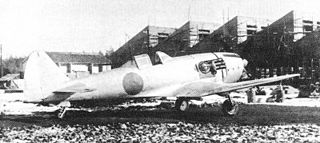
The Nakajima Ki-87 was a Japanese prototype high-altitude fighter-interceptor of World War II. It was a single seat, exhaust-driven turbo-supercharged engined, low-wing monoplane with a conventional undercarriage.

The Mitsubishi Ki-83 (キ83) was a Japanese experimental long range heavy fighter designed near the end of World War II. It did not reach production status.

The Rikugun Ki-93 was a prototype Japanese twin-engined fighter aircraft of the Second World War. Designed by the Army Aerotechnical Research Institute, to be a heavy fighter armed with large calibre cannon to serve in the anti-shipping or bomber destroyer roles, only one example of the Ki-93 was completed; this was damaged on its maiden flight, and destroyed by American bombing before it could be flown again.
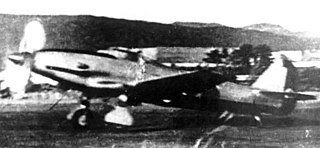
The Kawasaki Ki-64 was a one-off prototype of an experimental heavy, single seat fighter. It had two unusual design features. First, it had two Kawasaki Ha-40 engines in tandem; one in the aircraft nose, the other behind the cockpit, both being connected by a drive shaft. This combination drove two, three-bladed, contra-rotating propellers. The second feature was the use of the wing surface as a radiator for the water-cooled engines. The aircraft first flew in December 1943. During the fifth flight, the rear engine caught fire, and, while the aircraft made an emergency landing, it was damaged. The aircraft was subsequently abandoned in mid-1944 in favour of more promising projects. The airframe survived the war, and parts of the unique cooling system were sent to Wright Field for examination.


















